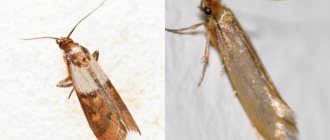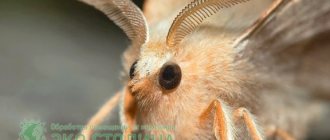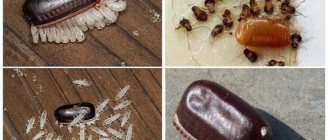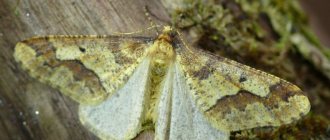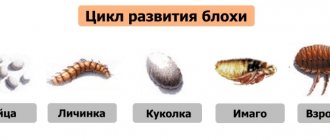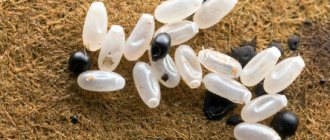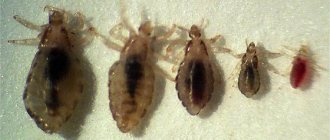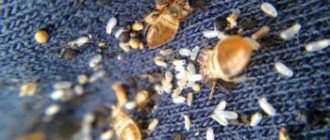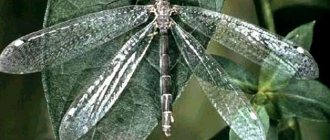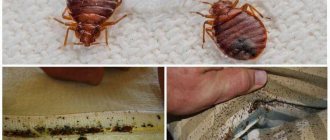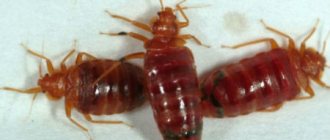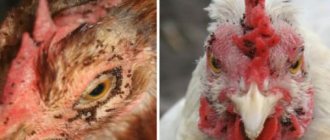A moth's lip is not stupid. She is not interested in cheap synthetics - give her fur. Silk and wool, natural and expensive, will also work. If she’s really hungry, she won’t disdain feathers and cotton. How to protect your most valuable things from an insatiable pest?
To win the war against clothes moths, you need to carefully study its preferences and find vulnerabilities, and then deprive it of pleasures and strike where it hurts the most. Only then will it be possible to get rid of the voracious insect once and for all.
Appearance of a moth larva
Everyone can imagine a small fruit worm, which is often found in apples or other fruits that have not been treated with pesticides. This will allow you to understand what a moth larva looks like.
Appearance of a moth larva
The pest caterpillar is pale yellow in color, has 12 limbs and a darker head. The length can be from 6 to 12 mm. Thickness no more than 2 mm.
Fruit caterpillars and moth larvae are similar in appearance, so the presence of pests in the house is easier to notice by flying silvery moths.
Prevention
To prevent the moth larva from actively destroying valuables or food, it is important to know how to prevent the pest from appearing in the house. To protect your home, it is important to follow a number of rules.
So, only washed items should be stored in closets. From time to time, all woolen or fur products and natural fabrics must be ventilated in frost or sun.
Other rules of prevention:
- Fur and wool must be periodically treated with insecticides.
- Items cannot be placed in plastic bags.
- Herbs that repel parasites (tansy, wormwood, lavender) should be placed in the wardrobe and chest of drawers.
- You can place citrus peels in the kitchen.
- On shelves with clothes you need to place pieces of foam rubber soaked in essential extracts.
- All food products that can be damaged by larvae must be periodically sorted and stored in closed containers.
- Regularly you need to carefully inspect all seams and folds on things for the presence of parasites.
Microscopic larvae can ruin expensive and valuable things. Therefore, it is easier to prevent their occurrence than to purchase a new fur coat, furniture or carpet.
To do this, it is important to follow the prevention rules described above. And at the first sign of moths appearing in the house, carry out a thorough disinfection.
Type of moth
The insect belongs to the butterfly family. About 30 different species of moths are known, half of which are capable of living at home.
Based on the type of feeding preferences, parasites can be divided into 2 groups: food and fur.
Food moth Coat moth butterfly
The most common household pests:
| Appearance of a moth | Clothes | Fur | Furniture | Barn |
| Color | Dark purple fading to beige | Light brown with black dots | Yellow with dark red | Silver gray |
| Wingspan | 20 mm | 15 mm | 10 mm | 15 mm |
| Power type | Natural and semi-synthetic fabrics, wool | Fur, natural materials | Upholstery | Bulk products (cereals, flour), dried fruits, groceries |
There are also several types of “vegetable” moths (cabbage, potato, wax moths), which appear in beds, gardens or apiaries, destroying green shoots and honeycombs. But these insects do not move into the home.
Moth: harm in the home
The appearance of flying insects in the apartment gives housewives a lot of trouble. Panic thoughts immediately arise about corroded woolen items, damaged upholstered furniture and scraps of fur falling out of a fur coat. Natural fabrics: silk, cotton are also susceptible to attack by parasites that feed on organic material.
Unfortunately, the harm is not limited to damage to clothing and sofa upholstery: some types of pests settle in cereals, flour, pasta, and get into packages of cookies, dried fruits, bran, and whole grains. The cabbage moth settles in heads of cabbage, the rye moth infests in the grain.
Scaly butterflies actively breed in the home: an abundance of food combined with a suitable air temperature, many secluded corners - an ideal habitat for parasitic insects. The greatest damage to a home is caused not by adult insects, but by voracious larvae. One clutch contains up to 100 worm-like caterpillars. It is easy to imagine the scale of harm caused by growing pests that eat cereals, wool fibers, grain, and fur.
It is easier to catch food moths: the parasite is larger than the clothes moth, and the wings are darker. Wool (clothing) moths resemble thin sticks of light yellow color; it is more difficult to notice the pest, especially if the color of the sweater or dress is dull.
Read about how to get rid of whiteflies on indoor flowers using chemicals and folk methods at this address.
How they develop and reproduce
The development cycle is standard for this class of insects. Adults lay white or silvery microscopic eggs, from which small caterpillars emerge.
This phase of the moth's life is the most dangerous for fabrics and dry foods. During the growth process, the larva requires the maximum amount of food, and the structure of the insect's jaws allows it to process a large amount of material.
Breeding cycle
After the moths appear, their main function will only be reproduction.
Males die immediately after mating. Females end their lives after laying eggs, the number of which can reach several hundred.
Insect species
Several varieties of parasitic insects inhabit the home. Each type causes considerable damage to the home. The fur and clothing varieties most often appear in apartments.
Another pest that annoys owners is food moths in the apartment. Larvae and adults feed on flour, pasta, cereals, grains, and dried fruits.
Upholstered furniture harbors a pest that feeds on the fibers of the fabrics that are upholstered on the sofa, armchairs, and chairs. Tiny dots appear in the affected area, lint falls out, and if you run your fingers over the corroded area, a hole will appear or the upper part will have “bald patches.” The less often the housewife cleans the products, the more damage the parasite larvae can cause. With high air humidity in the home, temperatures from +22 degrees or more, lepidopteran butterflies reproduce well.
Other types of moths are less common in the apartment:
cabbage; grain; rye; wax moth.
What do moth larvae eat?
The consequences of the life activity of the house moth larvae look like a mixture of gnawed fabric, fur or dry foods mixed with a dusty substance.
Wool, fur, clothing and furniture insects feed on natural or mixed fibers, including some types of synthetics. The fur moth is capable of laying a path along its route, which will look like a shorn strip.
Moth eats fur coat
A smaller variety of furniture parasites immediately selects upholstery areas with a large amount of material for laying eggs, so that the hatched individual is provided with food from the moment of birth and cannot die. A hole appears in the place where furniture moths live.
Feeding individuals destroy the structure of grains and cereals, turning them into dusty mush, held together by the biological material of caterpillars and eggs.
Moth eats cereal
Causes of infection
Often, infection occurs through the fault of the person himself; he brings it home independently with purchased items and products. If improperly stored in warehouses, contamination occurs, such goods are purchased by a person and brought to his home. Without seeing a clutch of eggs or larvae, he sends the product or clothing for storage in a closet, where favorable conditions are created for further development.
Pests multiply very quickly, so soon a person will see damage caused by insects. Therefore, when purchasing a product, you need to be very careful, inspect cereals, flour, nuts, dried fruits, grains, seeds, and animal feed.
Packaging does not guarantee the quality of the product at all; insects can easily gnaw their way through paper and polyethylene. You should also carefully inspect items made of wool, natural fur, rugs, fur hats, and shoes. Furniture with upholstery made from natural materials is no exception.
How to get rid of moth larvae
In order to effectively get rid of insects, you need to know their weaknesses. All varieties of moths will be afraid of bright light, strong odors, and large temperature changes (extreme cold or heat).
If colonies of insects have laid eggs in cereals and dry foods, then there is no point in saving them. Even after cooking or cooling inside the freezer, infection particles will remain in the mixtures.
The insect cannot tolerate large temperature changes
Cleaning sequence:
- Empty storage areas where butterflies or caterpillars have been spotted. Rinse all surfaces, including the joints between shelves, thoroughly adding a few drops of vinegar to the liquid.
- If there is a steam generator, then horizontal and vertical planes are treated with steam at a temperature of at least 70°C.
- As an alternative, you can use a hair dryer to dry your hair. If you set the hot air supply to maximum and direct it to the joints of the cabinet parts, this will eliminate the laid eggs.
- All products that have had contact with air should be packed in plastic bags and thrown out of the house.
- Storage containers must be washed in the dishwasher or disinfected in the freezer. Accommodation for 24 hours will be sufficient.
If voracious insects are infested in the dressing room, then you should not part with your clothes. General cleaning and disinfection are required.
gor_san_mos
gor_san_mos
gor_san_mos
Algorithm of actions:
- First of all, it is worth treating all the internal walls of the storage facility. This can be wet cleaning with vinegar, which is carried out similarly to the rules for cleaning kitchen cabinets. Next, taking into account the material used to make the shelves and partitions, a steam generator or hot air from a hair dryer is used.
- It is better to wash or iron things, linen and materials with which moths have come into contact with a steam iron with a high temperature spray of boiling water.
- You can resort to dry cleaning services. This option will be a salvation for delicate or fur items.
The problem with furniture insects is considered the most difficult, since large items or heavy carpet cannot be washed in a household washing machine.
Sofas, armchairs, beds and carpets can be cleaned:
- a washing vacuum cleaner with added chemicals;
- steam generator at maximum temperature;
- by calling furniture dry cleaning specialists.
All options that help get rid of moths can be divided into traditional and modern.
Traditional methods
Knowing at what temperature moth larvae die (heating above 43°C or freezing below 17°C), you can disinfect furniture or things in contrasting modes.
For example, it is recommended to take sofas and carpets outside in winter during severe frosts for a day. This will be enough to destroy the shell of the eggs. Small clothes and linens can be placed in the home freezer for 12 hours. After defrosting, simply wash and iron the items with a steam iron.
However, such radical methods will only withstand dense fabrics and upholstery.
A more delicate method to get rid of insects is persistent natural flavors:
- fresh and dried spicy herbs lavender, mint, wormwood, tansy, yarrow;
- orange peels;
- home flowers geranium and carnation;
- aroma oils;
- tobacco.
Chemicals
Modern developers of household chemicals can offer quick relief from pests:
- sprays for treating clothing and furniture;
- ready-made sachets with herbs that have a pungent odor;
- stickers for food moths;
- clothes moth tablets;
- automatic devices for repelling insects.
galinakorvai
pettown.ru
favorite_shop13
When using such products, you need to make sure that family members do not have allergic reactions to their composition.
Nutrition of larvae
The caterpillar feeds on a variety of foods or things. In nature, pests eat fruits, feathers, berries, wool, grains, vegetables or nuts.
Housewives in whose homes these parasites lived know what house moth larvae eat. Once in the house, insects begin to actively feed on hair, fur, and fabrics (linen, silk, cotton, wool).
Parasites also love to eat products made from natural fur. Moreover, insects choose old materials, which are better to chew and digest.
Clothes moth larvae are quite fastidious in their diet. They love to eat sweaty clothes or stained carpets.
Kitchen moth larvae consume bran, sweets, flour, cereals and nuts. Insects also eat cookies, pasta, tea, and dried fruits.
The larva's stomach is very small, so the parasite leaves behind an insignificant trace. Because of this, the presence of moths for a long time is often unnoticed. Parasites are discovered after their active reproduction, when the number of caterpillars becomes enormous.
So, moth larvae feed differently.
And the type of food determines the name of the insect:
| Type of insect | What does it eat? |
| Carpet | Paths, rugs, carpets |
| Fur coat | Fur coats, animal hair or products made from it |
| Cereal | Corn |
| Clothes | Felt products, fruits |
| Furniture | Furniture upholstery |
| Kitchen | Nuts, grains, seeds, dry fruits, legumes |
Why are moth larvae dangerous?
The greatest health hazard is foodborne pests. In a few weeks, they can settle in almost all grocery products and not only digest some of them, but also contaminate them with waste products.
The use of contaminated mixtures can lead to intoxication of the body.
The risk of illness when wearing things after clothing moths have lived in them without cleaning occurs primarily in people suffering from allergies. After using the fabric, the wearer's skin may become irritated.
Where do moths and their offspring come from in an apartment?
The sanitary condition of a human home and the appearance of a harmful house butterfly are in no way related events. The population may choose luxury apartments and housing of owners who are not prone to neatness. The main thing is the presence of an extensive nutritional base.
Can a moth come out of nowhere? If we consider the surrounding space to be such a substance, the answer is positive. A butterfly can fly into an apartment through an open window or an open door and stay.
Other methods of penetration:
- along with old furniture, the upholstery of which contained eggs;
- with things purchased in thrift stores;
- with products purchased from dubious markets;
- with pet hair.
Even if you haven’t seen a butterfly in your apartment, there are signs by which you can guess that there is an infestation. These are remnants of skin in boxes, which caterpillars shed when molting, stuck together lumps of cereals in jars, “cobwebs” on things, in the corners of cabinets.
The most favorable temperature for the existence of pest butterflies is 21-23°C. The warmer the apartment, the faster insects develop. But at temperatures above 30 °C, the voracious caterpillars die. Uninvited inhabitants of cabinets and containers with food supplies will never go outside in search of food. There they have natural enemies - birds, spiders, fresh cool air.
Ways to fight
It will be quite difficult to get rid of moths, since they are resistant to changes in temperature outside. If knitted scarves, mittens, or sweaters are damaged, you need to decide whether it is worth restoring the item or whether it is better to throw it away. Because there may be eggs left in the clothes, lost between the seams, which can become a step in the emergence of new larvae.
Folk remedies alone will not be enough if the number of moths and damaged things is large. Professionals advise buying chemicals to treat damaged items. We need to understand that we must fight not with adults, but with their larvae.
Onion fly: effective means and methods of control
The main thing to remember is that the kitchen and damaged products should not be treated with chemicals. Therefore, spoiled porridges and cereals should be thrown away. Eating foods that contain moths is strictly prohibited. When cleaning the kitchen, you should use detergents with the addition of soda, as this product has good disinfecting ability.
Effective means and methods for exterminating moths and their larvae
To get rid of moth larvae and adult butterflies, humanity has invented many methods of varying effectiveness. The recipes contain classic drugs, such as naphthalene and new generation insecticides. It is difficult to name the best remedy; you need to act experimentally. The fight should begin immediately after at least one small butterfly is noticed.
Before processing, you should throw away all contaminated food, damaged clothing, and clean the room. If the item of clothing can be saved, it is subjected to thorough cleaning or chemical treatment.
